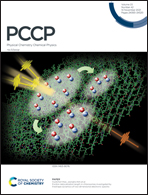The effect of hydration on the stability of ionic liquid crystals: MD simulations of [C14C1im]Cl and [C14C1im]Cl·H2O†
Abstract
The thermal range of the stability of Ionic Liquid Crystal (ILC) phases of imidazolium ILCs, and the type of the mesophase itself are affected by several molecular structural features, the two prominent ones being the alkyl chain length and the counter-anion. Hydration is also very important: monohydrate samples of 1-alkyl-3-methylimidazolium halides have a higher clearing point and a wider thermal range of the stability of the ionic smectic phase, compared with the analogous anhydrous sample. To understand the reasons, at a microscopic level, for such increased stability due to hydration, we run classical Molecular Dynamics (MD) simulations of a typical ionic liquid crystal, 1-tetradecyl-3-methylimidazolium chloride, and of its monohydrate form. We tested a full-charge non-polarizable force field and a scaled-charge version having the total charge of the ions scaled by a factor of 0.80. Comparison of the structural and dynamic properties with available experimental data reveals that the scaling of the charge by a factor of 0.80 results in a good agreement between simulated and experimental data and it sheds light on the microscopic mechanism responsible for the increased stability of the monohydrated phase. A hydrogen-bond network between water and the chloride anion is established in the ionic layer which increases the stability of the ionic layer; this in turn increases the nano-segregation between the ionic and hydrophobic layers which eventually produce an increased order of the alkylic layer as well.
![Graphical abstract: The effect of hydration on the stability of ionic liquid crystals: MD simulations of [C14C1im]Cl and [C14C1im]Cl·H2O](/en/Image/Get?imageInfo.ImageType=GA&imageInfo.ImageIdentifier.ManuscriptID=D1CP03757A&imageInfo.ImageIdentifier.Year=2021)


 Please wait while we load your content...
Please wait while we load your content...